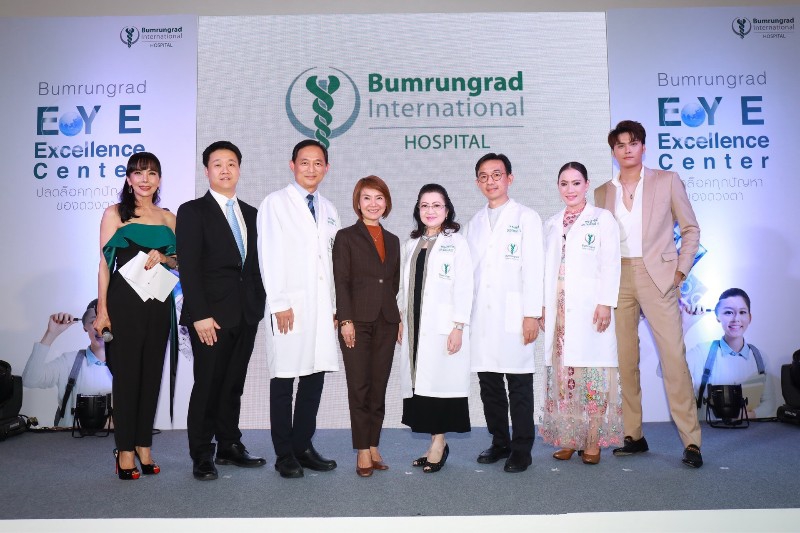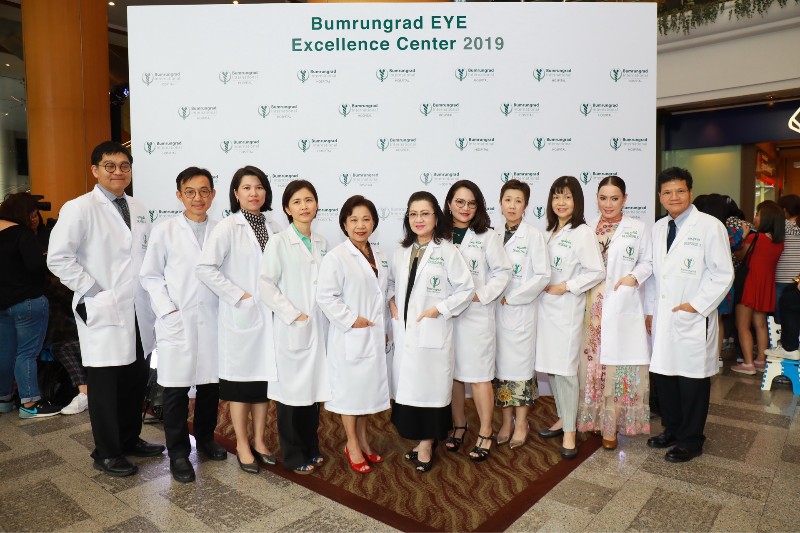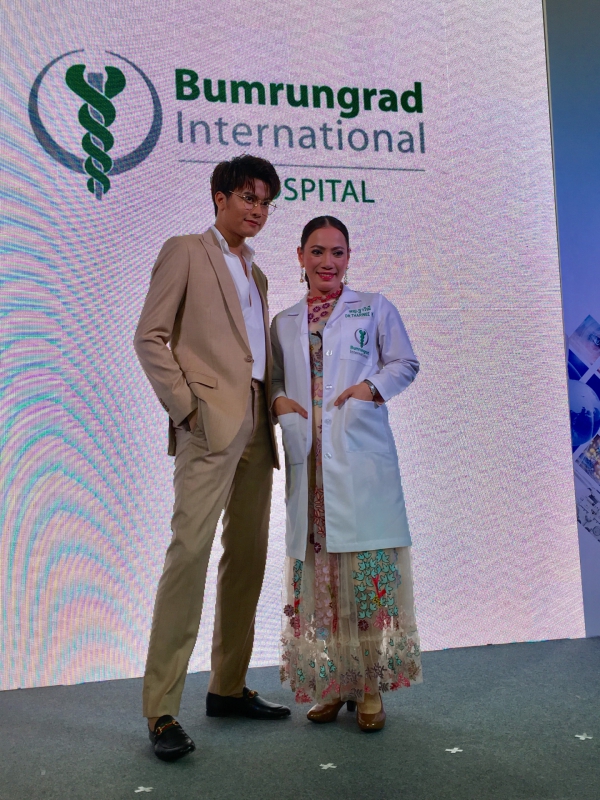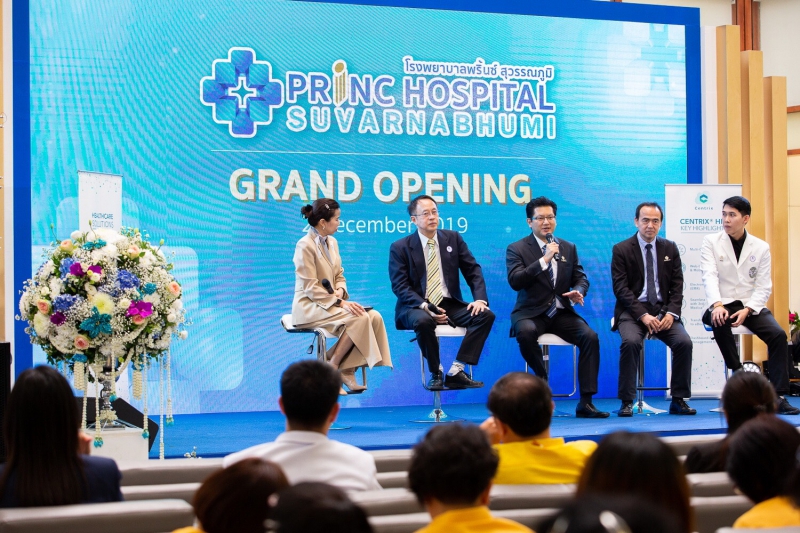Bumrungrad moves forward implementing the Smart Hospital 5.0 standards – introducing innovative ophthalmic surgical technology at its Eye Excellence Center Event.
According to a national survey conducted in 2013, blindness affected 0.6% of the population (360,000 people). The World Health Organization (WHO) set as a goal, in its WHO VISION 2020 Right to Sight Initiative, to reduce the incidence of blindness to 0.5% of population and to ultimately eliminate avoidable blindness.
Thailand will be an aged society sometime between 2024 and 2027—resulting in more older people having eye problems. Old-age is one of the main factors contributing to eye problems like cataracts, glaucoma, and age-related macular degeneration (AMD). These three conditions are the most common causes of blindness or blurred vision. In fact, eye problems can happen to anyone. In children, the onset of nearsightedness may start early and worsen every year. The Ministry of Public Health reports that 30% of children below 15 years of age are nearsighted. A major cause is spending a lot of time on a computer or a mobile screen. People over the age of 40 and people who have eye problems should have their eyes checked regularly so that ophthalmologists can give prompt treatment.
Associate Professor Dr. Sudarat Yaisawang, ophthalmologist, and Head of the Eye Center at Bumrungrad International Hospital, states, “Bumrungrad recognizes the incidence of eye problems increases every year. We have upgraded the Eye Center to provide comprehensive care for all eye health problems. By the work of ‘Eye Excellence Center’ of Bumrungrad Hospital consists of 3 dimensions: 1. Using innovative diagnostic and treatment technology 2. Conducting research on novel eye treatments to give better treatments & services and 3. Organizing and participating in academic conferences to share and exchange knowledge and experience.
The pace of change in medicine, including eye related diagnoses and treatments, is fast-moving. Each year Bumrungrad acquires new innovative equipment for minimally invasive surgery. We also use laser technology to treat our patients, reducing pain and recovery time. Laser technology is more accurate, quicker to perform, and causes fewer complications. Since patients are treated on an outpatient basis, their costs are reduced too.”
There are 49 ophthalmologists at the Eye Center. We collaborate and share our expertise and experience to treat eye problems such as cataracts, glaucoma, retina, uveitis, cornea & refractive surgery, oculoplastics & reconstructive surgery, pediatric eye problems, and neuro-ophthalmology disorders. Our integrated care team includes ophthalmologists, physicians, experts, pharmacists, nurses, and nursing assistants with innovative equipment to ensure our patients get the best treatment and services.
Dr. Sombat Srisuwanporn, Ophthalmologist of Bumrungrad Hospital states, “Cataracts cannot be cured by medicine alone – surgery is required. There have been improvements in surgical technology, as more than 40 years ago, when Intracapsular Cataract Extraction (ICCE) was introduced to treat cataracts, the whole lens including the lens capsule was removed, leaving the patient without a lens. The surgery was performed at the upper edge of the iris—cutting open 12-15 millimeters of eye tissue and forced patients to wear lenticular lenses post-operation, distorting their peripheral vision. Extracapsular Lens Extraction (ECCE) is another type of cataract surgery in which the lens is removed, but the lens capsule is left partially attached to allow the implantation of an intraocular lens (IOL). The surgery requires only 5-7 stitches. Today, neither ICCE nor ECCE are common practice.”
The latest technology for cataract treatment is Phacoemulsification, commonly referred to as ‘phacoe.’ Part of the lens that is damaged is emulsified and aspirated from the eye. It requires an incision of 2-4 millimeters, so it is minimally invasive. An intraocular lens implant (IOL), is placed into the remaining lens capsule. The IOL will last as long as the patient’s lifetime, so there is no need for additional surgery to replace it. Soon after the operation, the patient is able to see better. Moreover, at Bumrungrad, we use Femtosecond laser technology (‘femto’ for short). It is more precise and safer outcome because Optical Coherence Tomography is used to generate high resolution 3D images of the eye. Femto is laser-based and minimally invasive because it allows ophthalmic surgeons to minimize the size of capsulorhexis. The femtosecond laser then is used to break the cataracts into small pieces. Lastly, ultrasound is used to remove the lens. A precise and well-centered capsulorhexis enables the accurate positioning of the IOL, thus increasing its efficacy.
Associate Professor Dr. Prin Rojanapongpun, an ophthalmologist, specializing in cataract treatment of Bumrungard Hospital reveals, “Cataract surgery nowadays is becoming cataract refractive surgery. We target enhanced vision outcomes by improving precision in surgery and intraocular lens selections.” Current technology for cataract surgery employs Femtosecond laser and laser Wavefront Aberrometer to enhance the outcome of cataract with a computer-controlled and digital guidance system. Optical Coherence Tomography uses a 2-micron wavelength to scan the eye, generating a high-resolution 3D image. These are used to develop a detailed surgical treatment plan, resulting in a safer and more precise outcome.
The present treatment does not only aim at removing cataracts but ophthalmologists also able to customize the lens to suit each patient’s lifestyle. For example, they consider both the distant, intermediate, and near vision to suit the patient’s needs. They discuss the amount of time per day (or night) each patient spends driving or other tasks like working in front of a screen. Some patients want to play particular sports as well. Therefore, ophthalmologists design and customize IOLs for each patient’s individual needs. Sometimes, the left and the right eyes may even have different requirements.
Recently, Bumrungrad has put the ORA system into place, allowing ophthalmologists to provide the most accuracy and precision possible for our cataract patients. It uses laser wavefront aberrometry to assist intraocular lens measurement and selection. The technology also guides and verify the best possible Toric lens placement to correct patients’ astigmatism. The ORA system measures the sphere and cylinder for an eye in real-time. It reduces the error implicit in standard measurement procedures—which will significantly benefit in patients who have had LASIK or corneal refractive surgeries before. The ORA system is accurate and suitable for all patients.
Before cataract surgery, ophthalmologists measure and customize lens implants for each patient. The ORA system is attached to the operating microscope. When an ophthalmologist removes the crystalline lens, the ORA system directs a beam of low-intensity laser light into the eye during the surgical procedure to determine cylindrical & spherical shape of the eye, the position of the lens implant, the arc of contact, and the size of the lens implant. When the lens implant is inserted, the ORA system analyzes if the lens is the most suitable so that the surgeon can customize the lens implant during the operation. Our team of ophthalmologists, ophthalmic surgeons, and eye experts seek to achieve the best lens implant for each patient—resulting in better vision.
Dr. Tharinee Kulkamthorn, an expert in lasik and refractive surgery of Bumrungrad Hospital, reveals, “Information technology is key these days. People spend more time on the computer screen, smart phones or tablets to have access to information 24-7. Staring at a screen for a long time or looking at a dimly lit screen can cause eye problems, like pain, blurred vision, dry eyes, tired eyes, nearsightedness (in children), and other pediatric eye disorders. A suggestion for those spending a lot of time on a computer screen is the 20-20-20 rule. Every 20 minutes of looking at something near such as looking at a computer or mobile screen, or reading books, you should let your eyes rest by looking at something 20 feet away for 20 seconds. This way your eye muscles can rest and you would work upclose more efficiently.
At Bumrungrad we also provide ReLEx SMILE, which uses a femtosecond laser to correct nearsightedness and astigmatism. It is accurate and the corneal incision is only 2-4 millimeters long. Therefore, it affects the nerve cells in the cornea minimally. This incision technique also allows for faster healing time, while reducing dry eye and irritation. Post-surgery, the patient will have better vision, shorter recovery, and be able to resume their normal active lifestyle soon.
During the ReLEx SMILE operation, a gentle femtosecond laser is directed onto the cornea, while the patient is relaxed and comfortable. After the operation, there are fewer complications because the incision is very small. The ReLEx SMILE operation is for patients who do not want to wear glasses or contact lenses. It also works well with the people who are -10.00 D myopic and -5.00 D astigmatic. During consultation, our ophthalmologists work with their patients to diagnose and discuss if the ReLEx SMILE is appropriate for them. There are many factors to consider, like the thickness of the cornea, and the presence of other eye conditions (i.e. dry eyes). Moreover, suitable candidates should be 20 years old or older, and have had stable eyesight for at least a year. Also, they must not have diabetes or have problems controlling their blood sugar levels. They must not be pregnant or lactating. Our ophthalmologists always consider the risks, benefits, and safely implement each patient care plan.”
———————————————–






